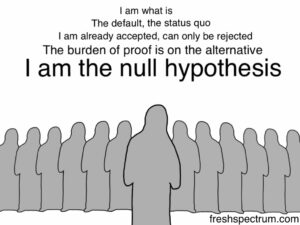For most studies, investigators have particular research questions that they would like to address. For instance, an investigator may wonder whether a new drug can prolong postoperative analgesia after total knee arthroplasty (TKA). Null and alternative hypotheses are declarative statements (not questions) that focus the statistical analyses of a study. Here, the null hypothesis (H0) would state “There is no difference in time to first request for pain medication following TKA between patients given the new drug and patients given the standard drug.” This may seem surprising inasmuch as the investigator’s interest must surely lie in differences other than zero. However, there are infinitesimal differences that are not zero, such as 0.01 and 0.002, 12.345, 987.65, and so forth – much too many to test in several lifetimes. So, as the scary cartoon suggests, there had to be a very specific null value – 0.00000 – on which to anchor the statistical tests.

On the flip side, alternative (also known as research) hypotheses might state H1 “Time to first request for pain medication following TKA differs between patients given the new drug and patients given the standard drug.” Or, H2 “Time to first request for pain medication following TKA is longer for patients given the new drug than for patients given the standard drug.” Or, H3 “Time to first request for pain medication following TKA is shorter for patients given the new drug than for patients given the standard drug.” One of the 3 must be selected: The first is nondirectional (2-tailed) and simply states that there is a difference; the other two are directional (1-tailed) and state that the difference is in the longer or shorter direction. Although our investigator is likely to chose H2 for this particular study, most studies in new areas of research are predicated on the nondirectional alternative.
Finally, it is important to note that hypotheses cannot be changed once data collection has begun. This is because the study design and statistical analysis plan had been set to test specific null and alternative hypotheses, and peeking at the data may allow the investigator to be unduly influenced to change them. Next month, statistics in small doses will cover the Type I and Type II errors and their importance in statistical decision making.



